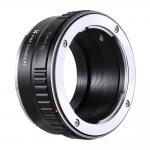I have several of these adapters for various lenses and would recommend these in a heartbeat. Good solid metal construction for a great price.
01.06.2017
Solid and effective.No glass so the optics are unaffected - holds my Vivitar 90mm f/2.5 solidly
18.04.2017
The fit and finish of this little adaptor is great works well on my camera and I am happy with it
15.01.2017
02.12.2016
1) All of my Zuiko lenses are sitting too far from the sensor - Infinity focus happens when their distance scales are at about 7 meters. This is not really an issue when manual focusing, but I can't rely on a lens barrel's Infinity stop. It's a good thing the Sony a6000 has Focus Peaking and Ficus Magnification - they are absolutely necessary for manual focusing at Infinity using these adapters.2) All of my Zuiko lenses can be focused more closely than on an OM body. This somewhat compensates the Infinity-focus problem. :-)3) All of my vintage zoom lenses lack the resolution that can be captured by the Sony a6000 24MP sensor. They are just soft, even in the center at f/8, even though they were mire than acceptable with film.4) Only five of my Zuiko primes are up to the task: 50mm f/1.8, 50mm f/3.5 Macro, 55mm f/1.2, 200mm f/4 and 300mm f/4.5. The rest are too soft, wide open, but ridiculously better at f8. The 50mm f/3.5 Macro and the 200mm f/4 are spectacular with the Sony a6000 (at 77mm and 308mm equivalents).5) The OM to E-mount adapter exacts about a 1/2-stop loss of speed from the vintage lenses, much as would any extension tube. It's not a problem, thanks to good high-ISO performance.6) Many lenses made for digital sensors are designed to deliver the light as perpendicularly as possible - to avoid the CA (chromatic aberration) "purple fringing" seen with lenses that were designed for film. I'm getting a lot of CA in the corners of the frame, but it's easily fixed in Photoshop. Note: There's no CA by shooting at f/8 instead of wide open.Lastly: I later bought a Fotodiox adapter and a Fotodiox Pro adapter for comparison and find them to be essentially identical in quality and function, so far, except the blades that engage the adapter to the camera body are about twice as thick with this K&F Concepts adapter and the Fotodiox Pro adapter, where the blades for this Fotodiox adapter are quite thin - which leads me to believe this K&F Concepts adapter (or the Fotodiox Pro adapter) would be the better choices when mounting a heavy lens (or perhaps any lens). Otherwise, the most significant difference is their weights. The aluminum and brass K&F Concepts adapter weighs 3.5 oz. The aluminum Fotodiox adapter weighs 3.2 oz. and the Fotodiox Pro weighs 3.1 oz. See photos...All three adapters have a length of 33mm, from the body mount to the lens mount, and again, they all focus well short of Ininfity.Again, the blades that engage the adapter to the Sony camera body are the same thickness for the Fotodiox Pro and the K&F Concepts, but are much thinner (for some reason) with the Fotodiox adapter. Oddly, they all feel the same when attaching lenses or when attaching to the camera body.If I had to do it all over again and money were no object, I would get the Fotodiox Pro, due to its being the lightest of the three at 3.1 oz. vs. 3.2 and 3.5 oz and having thick blades, rather than skinny blades. But the K&F Concepts comes out on top for having the best price, the thick blades similar to the Fotodiox Pro, but weighing 3.5 oz. instead of 3.1 oz. I would avoid the Fotodiox adapter due to its thin blades, where attached to the camera body - they do not inspire confidence. Again, the blades are thicker with the Fotodiox Pro and this K&F Concepts adapter.
28.11.2016
Worked Great, I did add a small modification to ensure a tighter fit though: inserting a tiny piece of paper between the adapter and the camera body and/or lens helped a ton. All metal, looks good, works well.
19.10.2016
This is a great adapter. I was really surprised by the build quality, as it is top notch. I use this to adapt my Olympus zuiko 50mm 1.8 les to my A7s2
19.08.2016

